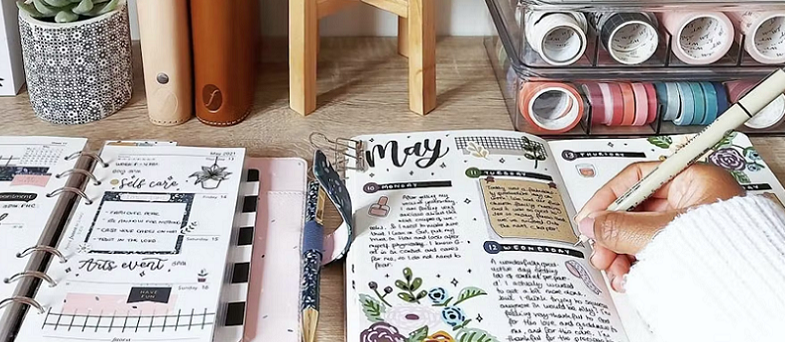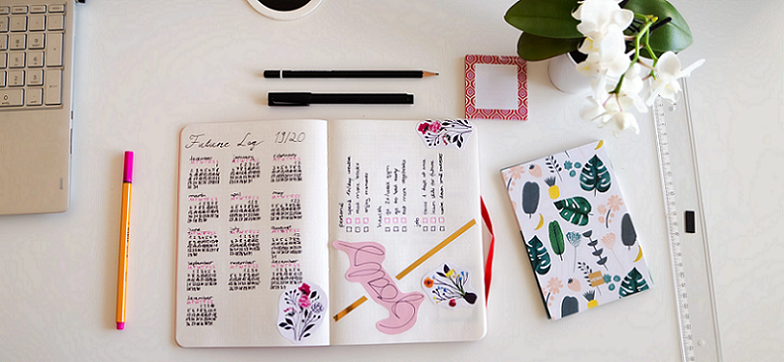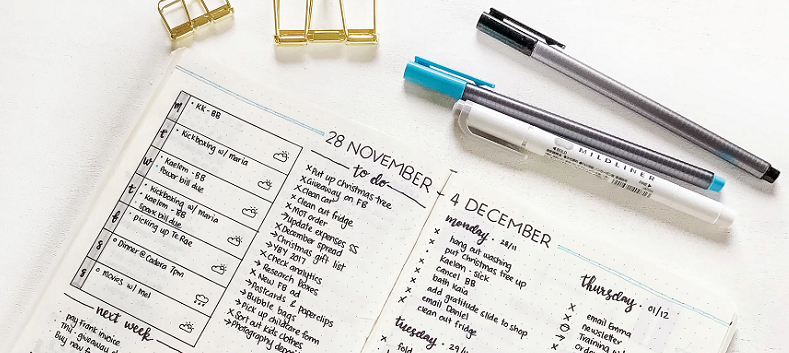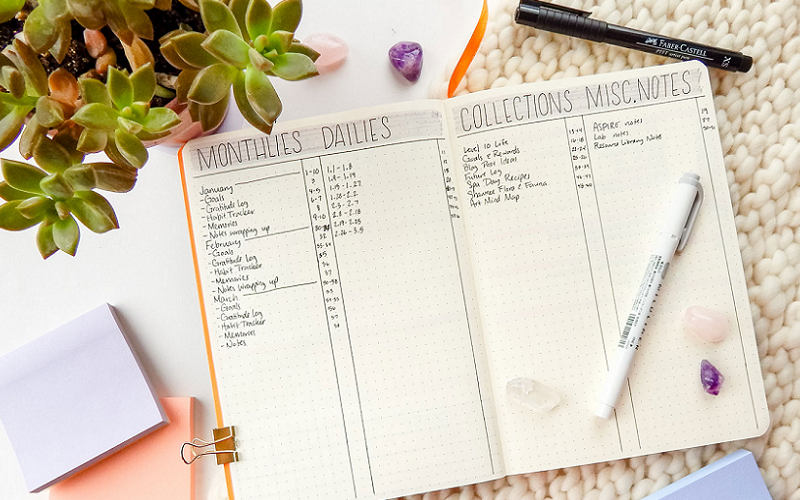In a world where our daily lives are full of endless to-do lists and appointments, bullet journaling has become an increasingly popular method for individuals to stay organized and productive. Bullet journaling allows you to create a personalized planner and journal that works best for your unique lifestyle and needs. Not only is it a practical tool for staying on top of your daily tasks, but it also serves as a creative outlet and a means of reducing stress and anxiety.
What Is Bullet Journaling?
Bullet journaling is a customizable organizational system that combines features of a planner, diary, and to-do list. It was developed by designer Ryder Carroll in 2013 as a way to manage his ADHD and be more productive. The idea behind bullet journaling is to create a system that is tailored to an individual’s specific needs and lifestyle.
At its core, bullet journaling involves using symbols to categorize tasks and events in a simple and efficient manner. These symbols consist of bullets, tasks, events, and notes. A bullet represents a task that needs to be completed, an event is represented by an open circle, and notes are indicated by a dash. A completed task is marked with an “X” and a task that has been migrated to another day or week is indicated by a right arrow “>”.
To set up a bullet journal, one needs a notebook and a writing tool. The notebook can be any type, such as a plain notebook, dotted notebook, or grid notebook. The writing tool can be a pen or pencil, and some people prefer to use colored pens or markers to differentiate between different types of entries.

The first pages of a bullet journal typically include a key or legend page, an index, a future log, and monthly and weekly logs. The key or legend page lists the symbols used in the journal, while the index serves as a table of contents for the entire journal. The future log is a place to record future events and tasks, while the monthly and weekly logs are where daily tasks and events are recorded.
One of the key benefits of bullet journaling is its flexibility. Users can customize their bullet journal to suit their own needs and preferences. This can include adding additional pages, such as habit trackers, mood trackers, or gratitude pages. It can also involve using stickers, washi tape, or other decorative elements to make the journal more visually appealing.
Bullet journaling has been shown to have mental health benefits as well. The act of writing things down can help reduce stress and anxiety by providing a sense of control and structure. The creative aspect of bullet journaling can also serve as a meditative practice and a way to express oneself.
Benefits of Bullet Journaling
Bullet journaling is a popular organizational system that offers a range of benefits for those who use it. What better way to highlight some of the key benefits of bullet journaling than by using a bullet list!
- Increased Productivity: By keeping all tasks, events, and notes in one place, bullet journaling helps users stay organized and focused. The act of writing things down also helps to commit them to memory, which can make it easier to complete tasks and remember deadlines.
- Reducing Anxiety and Stress: The act of writing down thoughts and feelings can be therapeutic and calming. Bullet journaling provides a safe and private space to express emotions, reduce stress, and gain clarity about one’s thoughts and feelings.
- Creative Outlet: Bullet journaling allows individuals to express their creativity and individuality. By customizing the design and layout of their journal, users can make it a reflection of their personality and style.
- Better Time Management: With a bullet journal, users can plan their days and weeks in advance, allowing them to make the most of their time. By prioritizing tasks and setting deadlines, they can become more efficient and effective in their work and personal lives.
- Improved Mental Health: Bullet journaling can help reduce symptoms of depression and anxiety by providing a structured and therapeutic outlet for emotional expression. It can promote mindfulness and self-reflection, helping individuals become more self-aware and mindful.
- Organization and Structure: A bullet journal provides structure and organization to one’s life. It allows for the efficient tracking of habits and goals, and encourages users to break down larger projects into manageable tasks.
- Motivation and Accountability: By tracking progress and setting goals, bullet journaling can help individuals stay motivated and accountable. Seeing progress over time can be a powerful motivator to continue working towards one’s goals.

How to Start Bullet Journaling
To start bullet journaling, you will need to gather the necessary supplies, including a notebook and a pen or pencil. You can use any type of notebook for bullet journaling, such as plain, dotted, or grid notebooks. Once you have your supplies, you can create a key or legend page to list the symbols you will use to categorize tasks and events in your journal. You can also set up an index or table of contents that will help you find information in your journal easily.
Next, you will need to create a future log to record events and tasks that will occur in the future, such as holidays and appointments. You can also create monthly and weekly logs to record daily tasks and events. Consider adding additional pages to your journal to track habits, goals, or gratitude, or to create collections of ideas, recipes, or quotes.
As you add tasks and events to your bullet journal, use symbols to categorize them according to their status or importance. For example, you can use a bullet to represent a task, an open circle to represent an event, and a dash to represent a note. You can also use symbols to mark completed tasks or migrated tasks.
To get the most out of your bullet journal, make sure to update it regularly. Set aside time each day or each week to review and update your journal. By following these steps, you can create a personalized planner and journal that will help you stay organized and productive.

Personalizing Your Bullet Journal
Personalizing your bullet journal is an important part of the bullet journaling process. One way to personalize your journal is to choose a theme that suits your interests or style. You can also use colors, stickers, and washi tapes to make your journal more visually appealing.
Another way to personalize your journal is to incorporate trackers, lists, and collections that align with your personal goals and interests. Adding personal touches to your journal can make it more enjoyable to use and can help you stay motivated and engaged with your tasks and goals.
Remember that your bullet journal is a reflection of your personality and style, so feel free to experiment with different techniques and designs until you find what works best for you.
Tips for Maintaining Your Bullet Journal
Maintaining your bullet journal is important to ensure it continues to serve its purpose as an organizational tool. Here are some tips to help you maintain your bullet journal:
- Be Consistent: Make an effort to update your bullet journal daily or weekly to keep it current and relevant.
- Embrace Your Mistakes: Don’t worry about making mistakes or creating perfect designs in your bullet journal. Embrace the process of creating and allow yourself to experiment and make mistakes.
- Don’t Compare Your Journal with Others: Remember that everyone’s bullet journal is unique and reflects their personal style and needs. Don’t compare your journal with others or feel pressure to create a certain type of design or layout.
- Regularly Review Your Journal: Take time to review your bullet journal regularly to assess your progress, adjust your goals, and identify areas for improvement.
- Use it as a Planning Tool: Your bullet journal is not just a place to record tasks and events but can also serve as a planning tool. Use it to set goals, create action plans, and prioritize tasks.
- Make it Fun: Incorporate elements that make your bullet journal enjoyable and fun to use. Use colorful pens, add stickers or washi tape, or include inspirational quotes or images to keep yourself motivated.
- Be Realistic: Set realistic expectations for yourself when using your bullet journal. Don’t overwhelm yourself with too many tasks or goals and prioritize what is most important.
Maintaining your bullet journal requires consistency, accepting mistakes, avoiding comparison with others, regularly reviewing it, using it as a planning tool, making it fun, and setting realistic expectations. By following these tips, you can make the most out of your bullet journal and achieve your goals efficiently and effectively.

